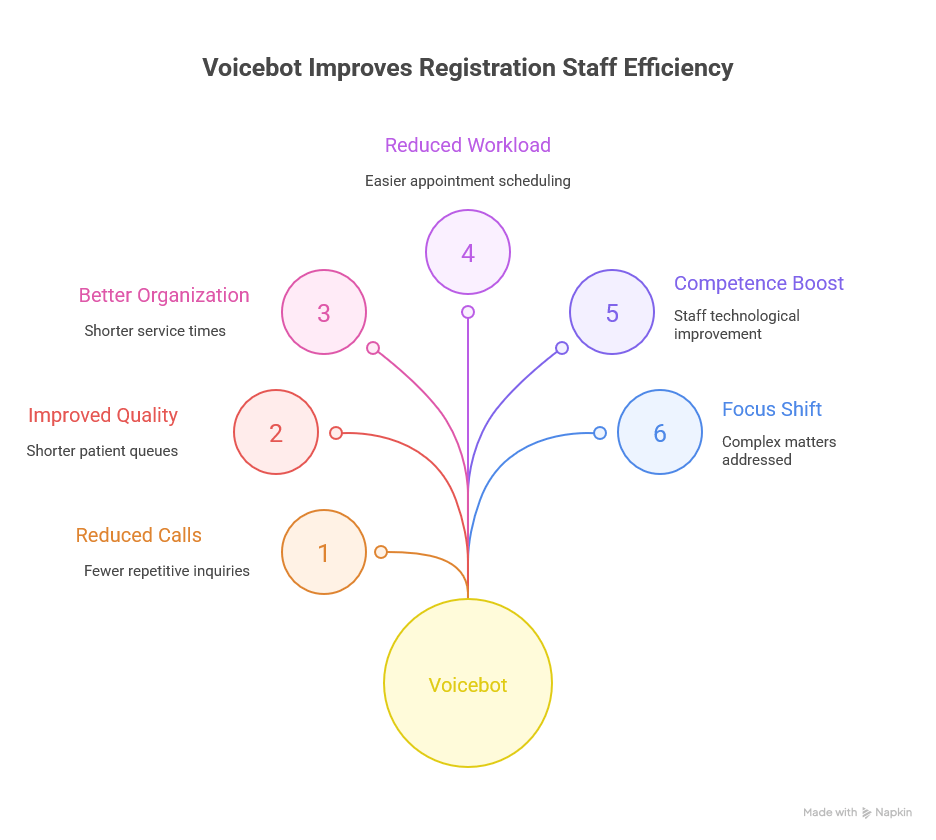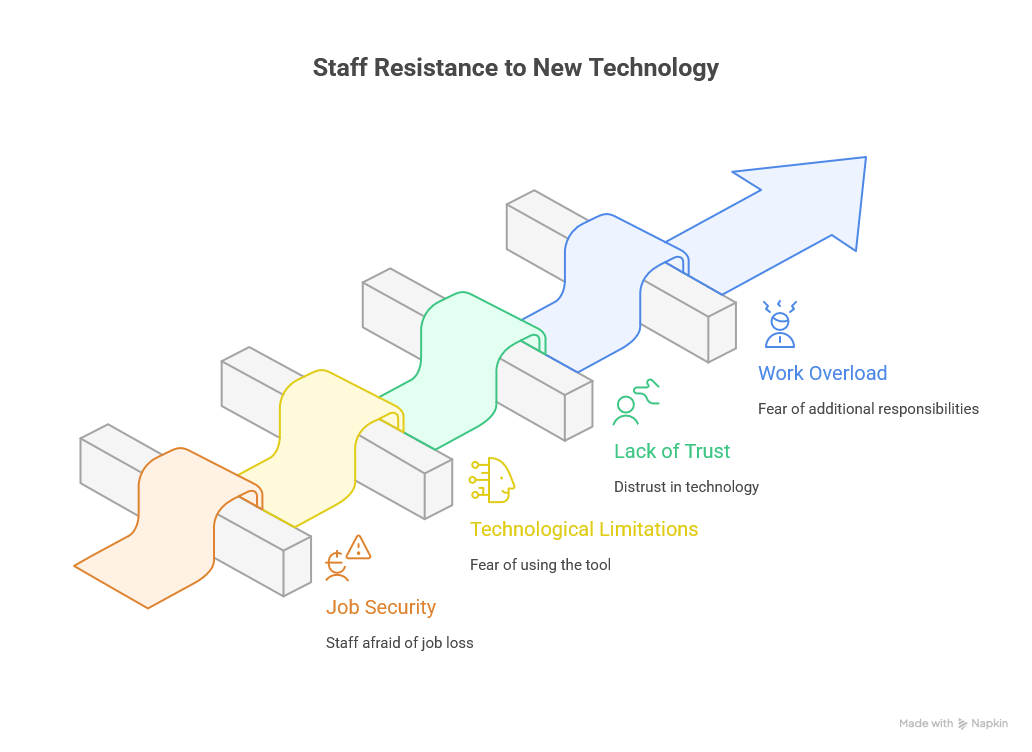How to prepare the registration team for collaboration with a voicebot in a clinic? Concerns, benefits, and proven practices
How to prepare the registration team for collaboration with a voicebot in a clinic? Concerns, benefits, and proven practices
Preparing a medical clinic’s registration team for the implementation of a voicebot should involve not only learning how to use the tool but also understanding the benefits that come with it. It’s natural for staff members to have concerns about job security or limited technological skills. How can you address these issues effectively? Below, we present proven practices that will make the implementation smoother and help your registration team adapt to upcoming changes.
Common concerns among registration staff before implementing a voicebot
Below are the most common concerns expressed by medical registration staff regarding the planned implementation of a voicebot for patient service. It’s crucial for clinic managers to recognize and understand their employees’ fears and then skillfully guide the entire implementation process.
Are staff members afraid of losing their jobs?
The most common concern is job loss. The registration team often fears that a medical voicebot will replace human employees. In reality, however, it serves as valuable support — and for now, electronic patient registration cannot fully replace the work of a human registrar. Many patients still prefer personal contact at the clinic, and some complex issues require staff involvement.
Technological limitations and fear of using the tool
Many employees worry that they won’t be able to operate the new tool correctly. Technology often triggers anxiety about limited digital skills. Therefore, it’s essential to carefully plan the implementation process and dedicate sufficient time to staff education. Today, AI voicebots have become standard in healthcare facilities and are designed to be easy to use. This reduces the risk of user errors and ensures that even older employees can handle the system. The key here is education and helping staff overcome their technological fears.
Lack of trust in technology
Another common reason for reluctance toward voicebot implementation is a general lack of trust in technology. Registration staff often note that AI tools lack emotions and empathy, which might hinder understanding patients or handling complex inquiries. This is precisely why voicebots are typically used to manage basic processes — such as patient registration, data verification, and answering frequently asked questions. More complex issues are handled by human staff, and this distinction should be clearly communicated to them. This approach minimizes the risk of errors and reduces employees’ anxiety.
Fear of additional responsibilities and work overload
The transition period following the introduction of an electronic patient registration system or other digital tools in the clinic often brings additional tasks. Staff must learn to use the new system while continuing their regular duties. Many people resist extra responsibilities, citing lack of time. However, it’s important to explain the purpose of these changes and the long-term benefits. A bit of extra effort now will make future work easier and more pleasant.
What benefits does a medical voicebot bring to the registration team?
Implementing a medical voicebot in the patient registration process allows staff to focus on more important tasks and organize their work better. They no longer need to answer the simplest inquiries or handle every registration manually. A large portion of the process is automated, reducing call queues and improving patient satisfaction with clinic services. As a result, conversations with registrars become friendlier and less stressful, improving workplace conditions.
The main benefits experienced by registration staff after implementing a voicebot include:
- a reduction in repetitive calls and elimination of routine tasks,
- improved call quality and greater patient satisfaction through shorter queues,
- better work organization and shorter service times,
- reduced workload during appointment scheduling,
- improved technological competence among registration staff,
- the ability to focus on the most important and complex matters, boosting daily efficiency.

These arguments for implementing a voicebot in patient registration should be thoroughly discussed with the team. Doing so will dispel many concerns and make the tool’s adoption much smoother. One common mistake made by clinic managers is proceeding with implementation without first preparing the staff. It’s vital to first present the benefits and use cases of a medical voicebot and then plan the entire process carefully.
Porozmawiaj z naszym specjalistą
Proven practices for implementing a voicebot in a medical facility
Below are several proven practices that make implementing a voicebot in a clinic much easier. They focus primarily on clear communication and active team engagement throughout the process.
Educating the team before implementation
Before the technical rollout begins, the team should be educated on the technological changes affecting the clinic. The goal is to build awareness of the necessity of modern tools and the advantages they offer. This stage should also focus on addressing employees’ concerns and clarifying misunderstandings. As part of this education, it’s helpful to present facts and myths about artificial intelligence in healthcare to avoid misconceptions.
Informing staff and patients about ongoing changes
During the implementation phase, maintain clear and transparent communication. Every staff member should be informed about the current status and what’s happening in the clinic. Communication should also include informing patients about the upcoming changes — through social media, posters, or notices in the clinic. This helps patients adapt more easily and fosters understanding. Such openness enhances the clinic’s reputation and facilitates service delivery.
Training the team to use the tool
During implementation, the team should undergo hands-on training on how to use the tool. Typically, this involves workshops led by the vendor’s representatives. Each registrar should receive specific instructions for using the system’s functions and clear procedures for handling possible errors or failures, including switching temporarily to manual registration. Training sessions should also include simulated conversations with the bot, allowing the team to become familiar with its behavior and features.
Dividing the implementation into stages
The entire implementation process should be divided into stages. This allows knowledge to be delivered in manageable portions. Overloading the team with information at once can lead to confusion and frustration. Gradual rollout helps staff adapt more smoothly. A proven approach is to start with basic features (such as appointment confirmations) and then gradually expand functionality based on feedback and comfort levels.
Collecting feedback from the team
Since the registration team uses the voicebot daily, regular feedback collection is essential. This should include both advantages and disadvantages of the tool. Feedback allows you to adjust processes, improve patient service quality, and enhance employee comfort and satisfaction.
Confirming the benefits through performance reports
How can you convince your team of the voicebot’s value? After several weeks of use, organize a summary meeting to present performance reports. These should highlight improved patient satisfaction and the number of cases handled automatically without staff intervention. Such tangible results best illustrate the tool’s benefits — saving time and improving organization. This helps persuade staff to actively and willingly use the voicebot, as well as other digital tools implemented in the clinic.
Join our healthcare clients
At EasyCall, we have extensive experience implementing medical voicebots in clinics. We fully understand both the needs of management and the concerns of staff. We address these by preparing a tailored implementation plan and adapting the tool to the facility’s real-world needs and capabilities. Contact our expert, who will guide you through the entire process.
Don’t wait — join our growing network of healthcare clients, including Rawicz County Hospital, Medica Kielce, Omega Medical Clinics, and many others. Discover all our success stories from the medical sector.

